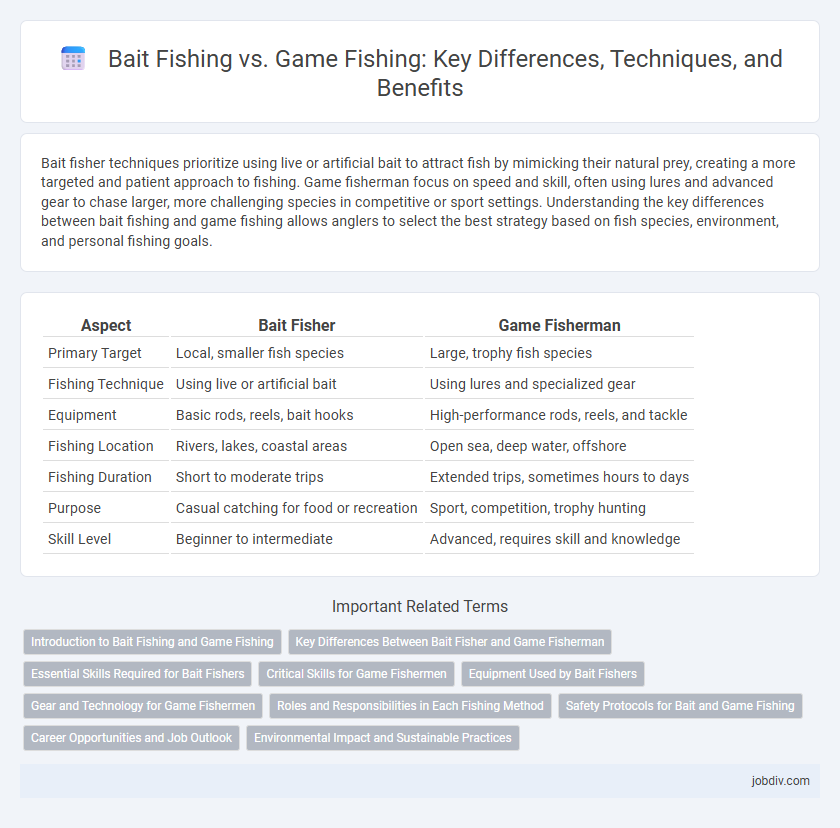Bait fisher techniques prioritize using live or artificial bait to attract fish by mimicking their natural prey, creating a more targeted and patient approach to fishing. Game fisherman focus on speed and skill, often using lures and advanced gear to chase larger, more challenging species in competitive or sport settings. Understanding the key differences between bait fishing and game fishing allows anglers to select the best strategy based on fish species, environment, and personal fishing goals.
Table of Comparison
| Aspect | Bait Fisher | Game Fisherman |
|---|---|---|
| Primary Target | Local, smaller fish species | Large, trophy fish species |
| Fishing Technique | Using live or artificial bait | Using lures and specialized gear |
| Equipment | Basic rods, reels, bait hooks | High-performance rods, reels, and tackle |
| Fishing Location | Rivers, lakes, coastal areas | Open sea, deep water, offshore |
| Fishing Duration | Short to moderate trips | Extended trips, sometimes hours to days |
| Purpose | Casual catching for food or recreation | Sport, competition, trophy hunting |
| Skill Level | Beginner to intermediate | Advanced, requires skill and knowledge |
Introduction to Bait Fishing and Game Fishing
Bait fishing involves using live or artificial bait to attract fish, making it a practical technique for catching a wide variety of species with minimal effort. Game fishing targets larger, sportier fish such as marlin, tuna, and bass, relying on specialized gear and techniques for active pursuit and challenge. Both methods have distinct appeals, with bait fishing emphasizing patience and simplicity, while game fishing focuses on skill and adrenaline-driven action.
Key Differences Between Bait Fisher and Game Fisherman
Bait fishers primarily use live or prepared bait to attract smaller, more abundant species, focusing on volume and frequent catches often in freshwater or nearshore environments. Game fishermen target larger, more challenging species such as marlin or tuna, relying on specialized gear, trolling techniques, and expert knowledge of fish behavior in offshore waters. The key differences lie in equipment sophistication, targeted fish species, and fishing techniques adapted to specific fishing goals.
Essential Skills Required for Bait Fishers
Bait fishers require proficiency in selecting the right bait types, understanding fish behavior, and mastering bait presentation techniques to effectively attract target species. Expertise in knot tying, casting accuracy, and reading water conditions significantly enhances bait fishing success. These essential skills differentiate bait fishers by enabling precise and strategic approaches to maximize catch rates.
Critical Skills for Game Fishermen
Game fishermen require advanced skills such as precise casting techniques, knowledge of fish behavior, and expertise in using specialized lures and bait to target trophy species effectively. Strong understanding of ocean currents, weather patterns, and fish habitats enhances their ability to locate and catch elusive game fish like marlin, tuna, and sailfish. Mastery in handling heavy-duty fishing gear and practicing ethical catch-and-release methods ensures sustainable and successful sport fishing experiences.
Equipment Used by Bait Fishers
Bait fishers rely primarily on simple, durable equipment such as bait traps, minnow buckets, and specialized bait rods designed to handle live or cut bait effectively. They often use circle hooks and bait needles to securely attach bait, optimizing catch rates while minimizing harm to the baitfish. The equipment is tailored to maximize bait presentation and longevity, ensuring the greatest attractiveness to target species during fishing expeditions.
Gear and Technology for Game Fishermen
Game fishermen utilize advanced gear such as high-strength braided lines, carbon fiber rods, and electronic fish finders to enhance their fishing efficiency and accuracy. Sophisticated reels with precision drag systems and durable hooks designed for large fish species provide game fishermen with the necessary tools to tackle challenging offshore environments. Cutting-edge technology like GPS mapping and underwater sonar significantly improves locating and targeting big game fish, distinguishing game fishing from basic bait fishing techniques.
Roles and Responsibilities in Each Fishing Method
Bait fishers specialize in using live or artificial bait to attract specific fish species, carefully selecting bait types to match target fish behavior and habitat. Game fishermen focus on pursuing larger, sport fish often using advanced techniques and specialized gear for catch-and-release or trophy catches. Both roles require knowledge of fish patterns, environmental conditions, and adherence to local fishing regulations to ensure sustainable fishing practices.
Safety Protocols for Bait and Game Fishing
Bait fishers prioritize using non-toxic, environmentally safe bait to prevent pollution and protect aquatic ecosystems, adhering to local regulations on bait collection and disposal to minimize ecological disruption. Game fishermen implement stringent safety protocols involving catch-and-release techniques, barbless hooks, and careful handling to preserve fish populations and reduce injury. Both practices emphasize personal safety through proper gear, such as life jackets and first aid kits, ensuring responsible and secure fishing experiences.
Career Opportunities and Job Outlook
Bait fishers typically find career opportunities in commercial fishing industries, seafood processing, or bait supply businesses, with steady demand driven by the fishing retail market. Game fishermen often pursue roles in sport fishing charters, fishing guide services, or tourism-oriented sectors, capitalizing on recreational fishing trends and seasonal demand. Job outlooks for both careers fluctuate with environmental regulations, fish populations, and regional economic conditions affecting fishery sustainability and tourism growth.
Environmental Impact and Sustainable Practices
Bait fishers often rely on small forage fish, which can disrupt marine food webs and deplete key species essential to ecosystem balance, whereas game fishermen typically target larger, less abundant species. Sustainable practices among game fishermen include catch-and-release techniques and using artificial lures to minimize habitat damage and bycatch. Emphasizing selective fishing methods and adhering to quotas can significantly reduce environmental impact and support long-term fish population health.
Bait Fisher vs Game Fisherman Infographic

 jobdiv.com
jobdiv.com